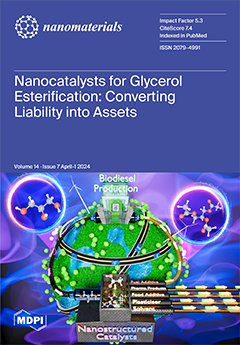Zinc oxide nanoparticles (ZnO NPs) have been investigated due to their distinct properties, variety of structures and sizes, and mainly for their antimicrobial activity. They have received a positive safety evaluation from the European Food Safety Authority (EFSA) for packaging applications as transparent
[...] Read more.
Zinc oxide nanoparticles (ZnO NPs) have been investigated due to their distinct properties, variety of structures and sizes, and mainly for their antimicrobial activity. They have received a positive safety evaluation from the European Food Safety Authority (EFSA) for packaging applications as transparent ultraviolet (UV) light absorbers based on the absence of significant migration of zinc oxide in particulate form. ZnO NPs with different morphologies (spherical, flower, and sheet) have been synthesized via different sol–gel methods and extensively characterized by several solid-state techniques, namely vibrational spectroscopy, powder X-ray diffraction (XRD), scanning electron microscopy/energy dispersive X-ray spectroscopy (SEM/EDS), Fourier Transform Infrared Spectroscopy (FTIR), ultraviolet–visible spectroscopy (UV-VIS), electron paramagnetic resonance (EPR), and nitrogen adsorption–desorption isotherms. The ZnO NPs were assessed for their antibacterial activity against
Escherichia coli (gram-negative bacteria) and
Staphylococcus aureus (gram-positive bacteria) to study the influence of morphology and size on efficacy. ZnO NPs with different morphologies and sizes demonstrated antimicrobial activity against both bacteria. The highest microbial cell reduction rate (7–8 log CFU mL
−1 for
E. coli and 6–7 log CFU mL
−1 for
S. aureus) was obtained for the sheet- and spherical-shaped NPs as a result of the high specific surface area. In fact, the higher surface areas of the sheet- and spherical-shaped nanoparticles (18.5 and 13.4 m
2 g
−1, respectively), compared to the flower-shaped NPs (5.3 m
2g
−1), seem to promote more efficient bacterial cell reduction. The spherical-shaped particles were also smaller (31 nm) compared with the flower-shaped (233 × 249 nm) ones. The flower ZnO NP resulted in a 4–5 log CFU mL
−1 reduction for
E. coli and 3–4 log CFU mL
−1 reduction for
S. aureus. The lower apparent antibacterial activity of the flower-shaped could be associated with either the lack of defects on the particle core or the shape shielding effect. Compared to
S. aureus,
E. coli seems to be less resistant to ZnO NPs, which may be explained by the characteristics of its cell membrane. With simple synthesis techniques, which do not allow the size and shape of the nanoparticles to be controlled simultaneously, it is a challenge to elucidate the effect of each of these two parameters on antibacterial performance.
Full article






